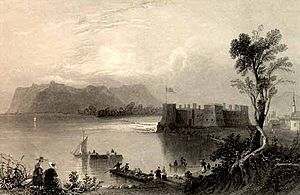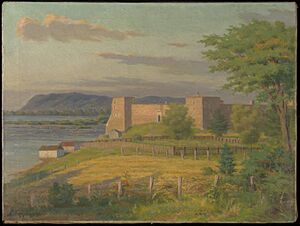Fort Chambly facts for kids
Quick facts for kids Fort Chambly |
|
|---|---|
 |
|
| Coordinates | 45°26′58″N 73°16′37″W / 45.44944°N 73.27694°W |
| Type | Fort |
| Site information | |
| Controlled by | New France; Great Britain; Canada |
| Site history | |
| Built | 1665 |
| In use | 1675–1776 |
| Battles/wars | Iroquois Wars — Seven Years' War — Invasion of Canada Campaign — American Revolution |
| Official name: Fort Chambly National Historic Site of Canada | |
| Designated: | 1920 |
Fort Chambly is an old, important fort in Quebec, Canada. It's officially recognized as a National Historic Site of Canada. This means it's a special place that helps us remember Canada's past. Long ago, it was called Fort St. Louis. It was one of five forts built along the Richelieu River. These forts helped keep people safe from the Iroquois people who lived nearby. This area is sometimes called "the Valley of Forts."
Contents
History of Fort Chambly
Fort Chambly is located by the Chambly rapids on the Richelieu River in Quebec, Canada. The French built the stone fort you see today in 1711. This was actually the third fort built on the same spot.
The First Fort: Fort Saint Louis
The very first fort was built in 1665. It was called Fort Saint Louis. Captain Jacques de Chambly built it. Its main job was to protect New France from attacks by the Iroquois people.
Rebuilding and Changes
In 1702, the fort was burned down by Indigenous people. But it was quickly rebuilt that same year. By then, people started calling it Fort Chambly.
A big peace agreement, the Great Peace of Montreal, happened in 1701. This ended the war between the French and the Iroquois. However, a new war, the War of the Spanish Succession, started in Europe. This war also affected the French and English colonies in North America.
To protect against stronger European attacks, especially from cannons, Governor Philippe de Rigaud Vaudreuil ordered the fort to be rebuilt in stone. This happened in 1709. Josué Boisberthelot de Beaucours was the engineer who designed and built the new stone fort. He also made big improvements to the fort between 1718 and 1720. He believed these changes would make the fort much stronger.
Fort Chambly's Role in Defense
For many years, Fort Chambly was a very important part of the defense system along the Richelieu River. This river was the easiest way for enemies to invade New France.
Later, other forts like Fort Saint-Frédéric (built in 1731) and Fort Saint-Jean (built in 1748) were built further south. Because of these new forts, Fort Chambly became less important for defense. It was then used as a warehouse and a meeting place for soldiers. But the fort was never completely empty.
Wars and Capture
During the Seven Years' War, Fort Chambly was made stronger and soldiers moved back in. However, it could not stop the British forces from reaching Montreal and Quebec City.
The strong stone fort we see today was taken by the British in August 1760. This happened during the Montreal Campaign as part of the French and Indian War.
American Revolution and After
American forces captured Fort Chambly on October 20, 1775. This was during the American Invasion of Canada of 1775–76. The Americans held the fort until the spring of 1776. Then, they left and burned it as they retreated south to Fort Ticonderoga.
After this, American soldiers who were captured, like Colonel William Stacy, were held as prisoners at Fort Chambly. They stayed there until the end of the American Revolutionary War.
During the American occupation, a group of soldiers called the 1st Canadian Regiment was formed. James Livingston created this group to help the American efforts during the invasion of Quebec. Livingston started recruiting men from Chambly in September 1775. The regiment was officially recognized in November 1775 and again in January 1776. This regiment never reached its full planned size of 1,000 men. They mostly fought in Canada and New York. The regiment was officially ended on January 1, 1781.
Restoration and Modern Day
After the Fenian Raids in the 1860s, when the fort was used again for a short time, it was left to fall apart. But in 1881, a citizen from Chambly named Joseph-Octave Dion personally repaired and restored the site.
In the 1900s, the Canadian government realized how important Fort Chambly was. They took over its care. Between 1965 and 1985, archaeologists dug up the site to learn more about it. Today, Parks Canada takes care of a fully rebuilt version of Fort Chambly, showing how it looked between 1718 and 1720. It is open to the public as the Fort Chambly National Historic Site of Canada.
Fort Chambly's Legacy
On June 28, 1985, Canada Post released a stamp featuring 'Fort Chambly, Que.' This stamp was part of a series called "Forts Across Canada." Rolf P. Harder designed the stamps.
Gallery
See also
 In Spanish: Fort Chambly para niños
In Spanish: Fort Chambly para niños
- St. Stephen's Anglican Church, a church built in 1820 for soldiers at the fort
Affiliations
The Fort Chambly Museum works with the CMA, the CHIN, and the Virtual Museum of Canada.















